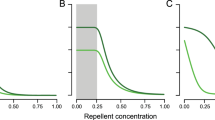Abstract
We tested the robustness of a structure-activity model for avian trigeminal chemoirritants. Fourteen benzoates and acetophenones were tested using European starlingsSturnus vulgaris as a bioassay. In general, the previously proposed model was a reasonable predictor of repellency (i.e., irritant potency). We found that the presence of a phenyl ring was critical to repellency. Basicity of the molecule is the next most critical feature influencing repellency. The presence of an acidic function within the electron-withdrawing functionality seriously detracts from repellency. The presence or absence of an electron-withdrawing or -donating group may potentiate repellent effects, but its presence is not critical, so long as the phenyl ring is electron rich. Our data suggest that there is ano-aminoacetophenone/methyl anthranilate trigeminal chemoreceptor in birds analogous to the mammalian capsaicin receptor. Both receptors contain a benzene site. However, birds seem to lack the associated thiol/hydrogen-bonding site present in mammals which is needed to activate the benzene site. Rather, birds may possess an associated exposed charged site that in turn may interact with the stimulus to activate the benzene site. These differences may explain the differential sensitivity of birds and mammals to aromatic irritants.
Similar content being viewed by others
References
Clark, L., andMason, J.R. 1993. Interactions between sensory and postingestional repellents in starlings: Methyl anthranilate and sucrose.Ecol. Appl. 3:262–270.
Clark, L., andShah, P.S. 1991. Nonlethal bird repellents: in search of a general model relating repellency and chemical structure.J. Wildl. Manage. 55:538–545.
Clark, L., andSmeraski, C.A. 1990. Seasonal shifts in odor acuity by starlings.J. Exp. Zool. 255:22–29.
Clark, L., Shah, P.S. andMason, J.R. 1991. Chemical repellency in birds: relationship between chemical structure and avoidance response.J. Exp. Zool. 260:310–322.
Dolbeer, R.A., Link, M.A., andWoronecki, P.P. 1988. Naphthalene shows no repellency for starlings.Wildl. Soc. Bull. 16:62–64.
Finger, T.E., Getchell, M.L., Getchell, T.V., andKinnamon, J.C. 1990. Affector and effector functions of peptidergic innervation of the nasal cavity, pp. 1–18,in B.G. Green, J.R. Mason and M.R. Kare (eds.). Chemical Senses, Vol. 2, Irritation. Marcel Dekker, New York.
Furia, V., andBellanca, N. 1971. Fenaroli's Handbook of Flavor Ingredients. CRC Press, Cleveland, Ohio.
Jakubas, W.J., Shah, P.S., Mason, J.R., andNorman, D.M. 1992. Avian repellency of coniferyl and cinnamyl derivatives.Ecol. Appl. 2:147–156.
Mason, J.R., andOtis, D.L. 1990. Effectiveness of six potential irritants on consumption by red-winged blackbirds (Agelaius phoeniceus) and starlings (Sturnus vulgaris); pp. 309–322,in B.G. Green, J.R. Mason and M.R. Kare (eds.). Chemical Senses, Vol. 2, Irritation. Marcel Dekker, New York.
Mason, J.R., Adams, M.J., andClark, L. 1989. Anthranilate repellency to starlings: chemical correlates and sensory perception.J. Wildl. Manage. 53:55–64.
Mason, J.R., Bean, N.J., Shah, P.S., andClark, L. 1991. Taxon-specific differences in responsiveness to capsaicin and several analogues: Correlates between chemical structure and behavioral aversiveness.J. Chem. Ecol. 17:2539–2551.
Nielsen, G.D. 1991. Mechanisms of activation of the sensory irritant receptor by airborne chemicals.Toxicology 21:183–208.
Schuler, W. 1983. Responses to sugars and their behavioural mechanisms in the starlings (Sturnus vulgaris L.).Behav. Ecol. Sociobiol. 13:243–251.
Shah, P.S., Mason, J.R., andClark, L. 1991. Prediction of avian repellency from chemical structure: The aversiveness of vanillin, vanillyl alcohol and veratryl alcohol.Pestic. Biochem. Physiol. 40:169–175.
Solzcsanyi, J., andJancso-Gabor, A. 1975. Sensory effects of capsaicin congeners I. Relationship between chemical structure and pain-producing potency of pungent agents.Arzneim.-Forsch. (Drug Res.) 25:1877–1881.
Solzcsanyi, J., Sann, H., andPierau, F.-K. 1986. Nociception in pigeons is not impaired by capsaicin.Pain 27:247–260.
Author information
Authors and Affiliations
Rights and permissions
About this article
Cite this article
Clark, L., Shah, P. Tests and refinements of a general structure-activity model for avian repellents. J Chem Ecol 20, 321–339 (1994). https://doi.org/10.1007/BF02064441
Received:
Accepted:
Issue Date:
DOI: https://doi.org/10.1007/BF02064441




